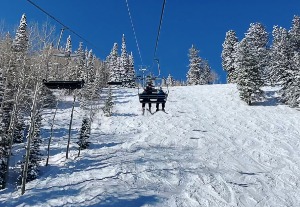How the Greatest Snow on Earth Affects Utah’s Economy
1/4/24 | Kinsey Love, Digital Marketing Manager

The 2022-2023 ski season was one for the record books. Alta Ski Area received a whopping 903 inches of snow last season setting the state’s all-time record. So far, the current ski season isn’t quite living up to the hype of last year, but snow totals remain to be seen. Despite snow totals, when Utah transforms into a winter wonderland, how does it impact the state’s economy?
The ski industry in Utah has experienced exponential growth in recent years, contributing significantly to the state's economic well-being. According to the Utah Office of Tourism, the ski industry generated over $800 million more during the 2021-2022 winter season than the previous one. This impressive figure encompasses expenditures on lift tickets, accommodations, equipment rentals, dining, car rentals, and various other associated activities. The 2022-2023 ski season saw a record-breaking 7.1 millions skier visits.
The backbone of Utah's ski industry success is its array of world-class ski resorts. Destinations such as Park City Mountain Resort, Deer Valley Resort, Alta Ski Area and Snowbird have become synonymous with premier skiing and snowboarding experiences. These resorts not only draw domestic visitors but also attract international tourists, boosting the state's tourism revenue. Utah ski and snowboard visitors spent a record $2.35 billion in the Utah economy during the 2021-2022 ski season. Tourism plays a major role in this number with out-of-state visitors spending nearly four times as much as local skiers.
The economic impact extends beyond the resorts, reaching local businesses and communities. Ski towns such as Park City and Sundance experience a surge in economic activity during the winter months, with hotels, restaurants, and shops benefiting from the influx of visitors looking for adventure and relaxation. According to the Gardner Policy Institute, the ski industry contributes over 19,000 jobs, from ski instructors and lift operators to hospitality staff and retail workers.
The winter recreation industry also has an impact on the real estate market. Real estate in ski-centric areas has seen substantial growth in recent years. The allure of living near world-class ski resorts has led to increased demand for homes and vacation properties, driving up property values and stimulating the construction and real estate sectors in those areas.
The ski industry plays such a big part in Utah’s economy that the State is looking for new methods of improving the ski infrastructure to handle the demand. In recent years, proposals for a new mode of transportation up Little Cottonwood Canyon have been considered to help alleviate the stress and congestion in the canyon. Dave Fields, President and CEO of Snowbird, discussed some of the considerations being made with Altabank on the Altabanking Podcast.
